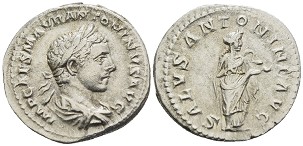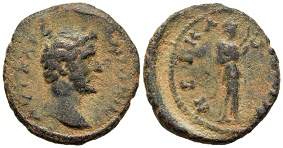Fine Coins Showcase
Antiquities Showcase
Show Empty Categories
Shop Search
Shopping Cart
My FORVM
Contact Us
About Forum
Shopping at Forum
Our Guarantee
Payment Options
Shipping Options & Fees
Privacy & Security
Forum Staff
Selling Your Coins
Identifying Your Coin
FAQs
zoom.asp
Home ▸ Catalog ▸ |Themes & Provenance| ▸ |Types| ▸ |Medical & Health||View Options:   | | | | | | |


Salus was the Roman goddess of health. She was Hygieia to the Greeks, who believed her to be the daughter of Aesculapius, the god of medicine and healing, and Epione, the goddess of soothing of pain. Coins dedicated to Salus Augusti, like this coin, probably indicate the emperor was at the time suffering from some disease, and sacred rites had been performed for his recovery. RS114329. Silver denarius, RSC II 1323b, Strack II 81, RIC II-3 564 var. (draped), BMCRE III 313 var. (same), RIC II 138 var. (head only), Hunter II -, SRCV II -, Choice VF, well centered, flow lines, tiny edge cracks, weight 3.084 g, maximum diameter 19.2 mm, die axis 180o, Rome mint, late 121 - 123 A.D.; obverse IMP CAESAR TRAIAN HADRIANVS AVG, laureate, draped and cuirassed bust right, cuirass cropped of its pteryges, seen from the front; reverse P M TR P COS III (Pontifex Maximus, Tribunitia Potestas, Consul Tertium - High priest, holder of tribunitian power, consul for the 3rd time), Salus standing slightly left, head left, patera in right feeding snake wrapped around altar, scepter (or Spear) in left, SAL - AVG across fields; very rare bust variety;
Hadrian, 11 August 117 - 10 July 138 A.D.


Salus was the Roman goddess of health. She was Hygieia to the Greeks, who believed her to be the daughter of Aesculapius, the god of medicine and healing, and Epione, the goddess of soothing of pain. Her father Asclepius learned the secrets of keeping death at bay after observing one snake bringing another snake healing herbs. Woman seeking fertility, the sick, and the injured slept in his temples in chambers where non-poisonous snakes were left to crawl on the floor and provide healing.RS114326. Silver denarius, RIC II-3 374, RIC II 137a, BMCRE III 314, RSC II 1324, Hunter II 112, Strack II 80, SRCV II 3539 var. (sl. drapery), Choice VF, well centered, toned, flow lines, edge split/crack, weight 3.140 g, maximum diameter 17.9 mm, die axis 180o, Rome mint, 119 - 120 A.D.; obverse IMP CAESAR TRAIAN HADRIANVS AVG, laureate head right; reverse P M TR P COS III, Salus seated left, feeding snake rising from altar before her from patera in right hand, resting left elbow on on back of chair, SAL AVG (to the health of the Emperor) in exergue;
Elagabalus, 16 May 218 - 11 March 222 A.D.


The reverse refers to Elagabalus' health, perhaps indicating that with the help of Salus he had recovered from an illness.RS115098. Silver denarius, RIC IV 140, RSC III 256, BMCRE V 28, SRCV II 7543, Hunter III -, Choice VF, excellent portrait, well centered on a broad flan, flow lines, weight 3.144 g, maximum diameter 19.5 mm, die axis 180o, Rome mint, 218 - 219 A.D.; obverse IMP CAES M AVR ANTONINVS AVG, laureate, draped, and cuirassed bust right, seen from behind; reverse SALVS ANTONINI AVG, Salus standing half right, diademed head right, with right hand feeding snake held in left; from the estate of Curtis D. Barker, ex Littleton Coin Company;
Hadrian, 11 August 117 - 10 July 138 A.D.


Salus was the Roman goddess of health. She was Hygieia to the Greeks, who believed her to be the daughter of Aesculapius, the god of medicine and healing, and Epione, the goddess of soothing of pain. Her father Asclepius learned the secrets of keeping death at bay after observing one snake bringing another snake healing herbs. Woman seeking fertility, the sick, and the injured slept in his temples in chambers where non-poisonous snakes were left to crawl on the floor and provide healing.RS114324. Silver denarius, RIC II-3 198, RIC II 139, BMCRE III 321, RSC II 1353, Hunter II 118, Strack II 79, SRCV II 3539 var. (SAL AVG), Choice VF, well centered, flow lines, small edge cracks, weight 3.370 g, maximum diameter 18.7 mm, die axis 225o, Rome mint, 119 - 120 A.D.; obverse IMP CAESAR TRAIAN HADRIANVS AVG, laureate bust right, bare chest (heroic bust) with drapery on far shoulder; reverse P M TR P COS III, Salus seated left, from patera in right hand, feeding snake rising from altar before her, resting left elbow on on back of chair, SALVS AVG (to the health of the Emperor) in exergue;
Hadrian, 11 August 117 - 10 July 138 A.D.


Salus was the Roman goddess of health. She was Hygieia to the Greeks, who believed her to be the daughter of Aesculapius, the god of medicine and healing, and Epione, the goddess of soothing of pain. Coins dedicated to Salus Augusti, like this coin, probably indicate the emperor was at the time suffering from some disease, and sacred rites had been performed for his recovery.RS114328. Silver denarius, RIC II-3 2344, RSC II 1329, BMCRE III 726, Strack II 266, Hunter II 241, SRCV II -, VF, centered, flow lines, toning, edge crack/split, weight 3.135 g, maximum diameter 18.6 mm, die axis 180o, Rome mint, 137 - Jul 138 A.D.; obverse HADRIANVS AVG COS III P P, bare head right; reverse SALVS AVG (the health of the Emperor), Salus standing half left, head left, sacrificing out of patera in right hand over lighted altar, scepter in left hand;
Antoninus Pius, August 138 - 7 March 161 A.D., Nicaea, Bithynia


Nicaea remained an important town throughout the imperial period. Although only 70 km (43 miles) from Constantinople, Nicaea did not lose its importance when Constantinople became the capital of the Eastern Empire. The city suffered from earthquakes in 358, 362 and 368; after the last of which, it was restored by Valens. During the Middle Ages, it was a long time bulwark of the Byzantine emperors against the Turks.RP113281. Bronze AE 17, apparently unpublished variant; RIC IV.1 T5889 var. (obv. leg.); SNG Cop 474 (same); Rec Gén 95.2, pl. LXIX.2 (rev. only) (same), VF, rev. off centered, porosity, light marks, clay-rich sediments, weight 3.752 g, maximum diameter 19.5 mm, Nicaea (Iznik, Turkey) mint, 138 - 161 A.D.; obverse AVT KAIC ANTΩNINO-C, Bare head right; reverse NEIKA-IEΩN, Hygieia standing right, feeding serpent in her arms from patera in right hand; extremely rare;
Valerian I, October 253 - c. June 260 A.D., Cotiaeum, Phrygia


Asklepios is the Greek god of medicine. Hygieia is the goddess of health and Asklepios' daughter. Telesphoros is Asklepios' assistant. Asklepios learned the secrets of keeping death at bay after observing one snake bringing another snake healing herbs. Woman seeking fertility, the sick, and the injured slept in his temples in chambers where non-poisonous snakes were left to crawl on the floor and provide healing.RP110209. Bronze tetrassarion, SNG Hunt 2048; SNG Mu 333 var. (rev. leg.); SNG Cop 337 var. (same) BMC Phrygia p. 177, 94 var. (bust); SNGvA 3791 var. (Telesphoros in center), VF, dark near black patina, light deposits, near centered, die wear, small rev. die crack/breaks, weight 7.089 g, maximum diameter 25.1 mm, die axis 195o, Cotiaeum (Kutahya, Turkey) mint, Oct 253 - c. Jun 260 A.D.; obverse AVT K Π ΛIK OVAΛEPIANON, radiate, draped, and cuirassed bust right, seen from behind; reverse EΠ Π AIΛ ΔHMHETPIANOY IΠ (P. Ailios Demetrios hipparchos, HM ligate), Hygieia, on left, standing right, feeding serpent in right hand from patera in left hand; Asklepios, on right, standing facing, head left, leaning with right hand on serpent-entwined staff; AP/X (archon) in two lines above center, KOTIAEΩN (ΩN ligate) in exergue;
Syracuse, Sicily, Roman Rule, 212 - c. 189 B.C.


Overcoming formidable resistance and the ingenious devices of Archimedes, the Roman General Marcus Claudius Marcellus took Syracuse in the summer of 212 B.C. Archimedes was killed during the attack. The plundered artworks taken back to Rome from Syracuse lit the initial spark of Greek influence on Roman culture.GI114972. Bronze AE 12, Calciatti II 223, SNG Cop 908, SNG München 1494, HGC 2 1529 (R1), SNG ANS -, F, green patina, earthen deposits, weight 1.772 g, maximum diameter 12.2 mm, die axis 0o, Syracuse mint, 212 - c. 189 B.C.; obverse bearded and laureate head of Asklepios right; reverse ΣYPAKOΣIΩN, serpent coiled around a staff; ex Classical Numismatic Group mail bid 78 (14 May 2008), lot 124, (part of); first example of this type handled by FORVM; scarce;
Commodus, March or April 177 - 31 December 192 A.D., Akrasos, Lydia


Akrasos was probably located on the upper course of the Caicus River. The site remains unknown. Even which river was once called the Caicus is uncertain. It is believed to be the modern Bakircay River in Turkey. Nothing is known of the city beyond its coinage.RP111751. Bronze AE 26, GRPC Lydia Acrasus 27, RPC Online IV.2 T2794, SNG Mun 19, BMC Lydia -, SNGvA -, Choice F, dark green patina, highlighting earthen deposits, porosity, weight 9.202 g, maximum diameter 25.9 mm, Acrasus (site unknown) mint, under Marcus Aurelius, c. 177 - 179 A.D.; obverse AV KAI Λ AVP KOMOΔ, laureate, draped, and cuirassed bust right; reverse EΠI CTPA BACCOV AKPACIΩTΩ (authority of strategos Bassos, Akrasos), Hygieia on left, standing half right, feeding serpent from patera held in her arms; Asclepius on right, standing facing, head left, leaning on serpent-entwined staff; ex CNG e-auction 510 (23 Feb 2022), lot 405; ex Dr. Jay M. Galst Collection ;
Volusian, c. November 251 - July or August 253 A.D., Roman Provincial Egypt


In 252, the Persian Emperor Shapur I invaded Armenia and, taken by surprise, destroyed a large Roman army at Barbalissos. He then invaded the defenceless Syrian provinces, captured all of its legionary posts and ravaged its cities, including Antioch, without any response. In 253, Uranius Antoninus (a priest and descendant of the royal house of Emesa) confronted Sapor and forced him to retreat. Uranius Antoninus also, however, proclaimed himself emperor.SH54364. Billon tetradrachm, Dattari 5124, Milne 3843, Curtis 1474, Emmett 3680, Choice VF, weight 11.688 g, maximum diameter 24.5 mm, die axis 0o, Alexandria mint, 252 - 253 A.D.; obverse ANT K Γ ANTΦ ΓAΛ B BOΛOYCIANOC EVC, laureate, draped, and cuirassed bust right; reverse laureate bust of Asklepios right, himation on left shoulder, serpent staff before, LΓ (year 3) behind; very rare; SOLD
CLICK HERE TO SEE MORE FROM THIS CATEGORY - FORVM's PRIOR SALES



REFERENCES
Page created in 1.563 seconds.








